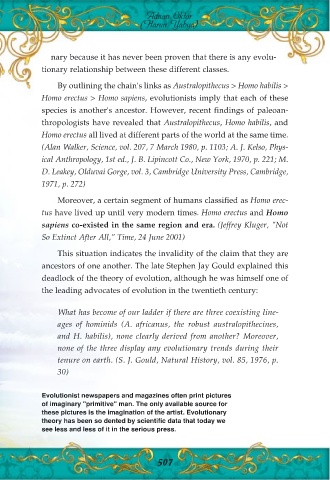Page 509 - Bigotry: The Dark Danger
P. 509
Adnan Oktar
(Harun Yahya)
nary because it has never been proven that there is any evolu-
tionary relationship between these different classes.
By outlining the chain's links as Australopithecus > Homo habilis >
Homo erectus > Homo sapiens, evolutionists imply that each of these
species is another's ancestor. However, recent findings of paleoan-
thropologists have revealed that Australopithecus, Homo habilis, and
Homo erectus all lived at different parts of the world at the same time.
(Alan Walker, Science, vol. 207, 7 March 1980, p. 1103; A. J. Kelso, Phys-
ical Anthropology, 1st ed., J. B. Lipincott Co., New York, 1970, p. 221; M.
D. Leakey, Olduvai Gorge, vol. 3, Cambridge University Press, Cambridge,
1971, p. 272)
Moreover, a certain segment of humans classified as Homo erec-
tus have lived up until very modern times. Homo erectus and Homo
sapiens co-existed in the same region and era. (Jeffrey Kluger, "Not
So Extinct After All," Time, 24 June 2001)
This situation indicates the invalidity of the claim that they are
ancestors of one another. The late Stephen Jay Gould explained this
deadlock of the theory of evolution, although he was himself one of
the leading advocates of evolution in the twentieth century:
What has become of our ladder if there are three coexisting line-
ages of hominids (A. africanus, the robust australopithecines,
and H. habilis), none clearly derived from another? Moreover,
none of the three display any evolutionary trends during their
tenure on earth. (S. J. Gould, Natural History, vol. 85, 1976, p.
30)
Evolutionist newspapers and magazines often print pictures
of imaginary "primitive" man. The only available source for
these pictures is the imagination of the artist. Evolutionary
theory has been so dented by scientific data that today we
see less and less of it in the serious press.
507

